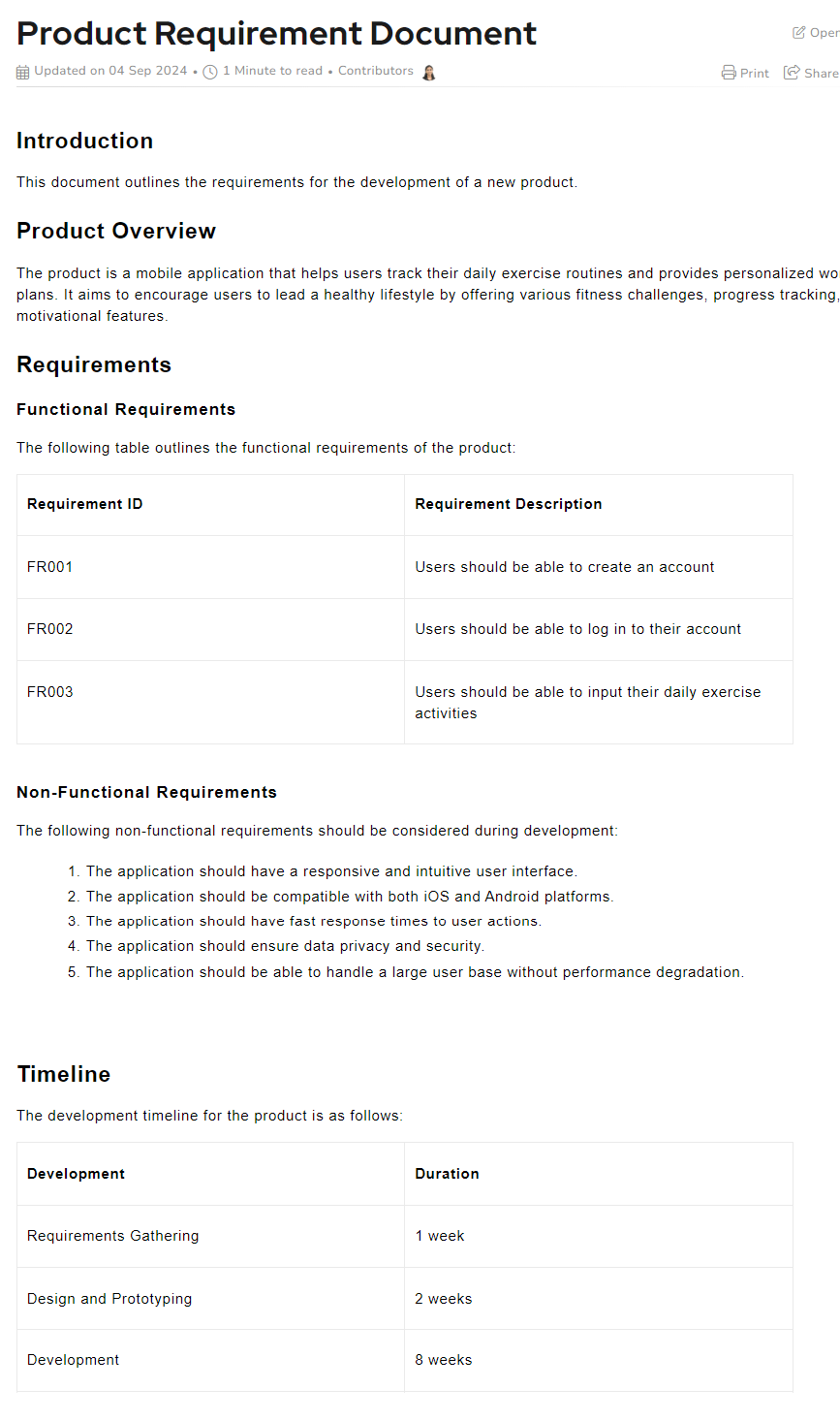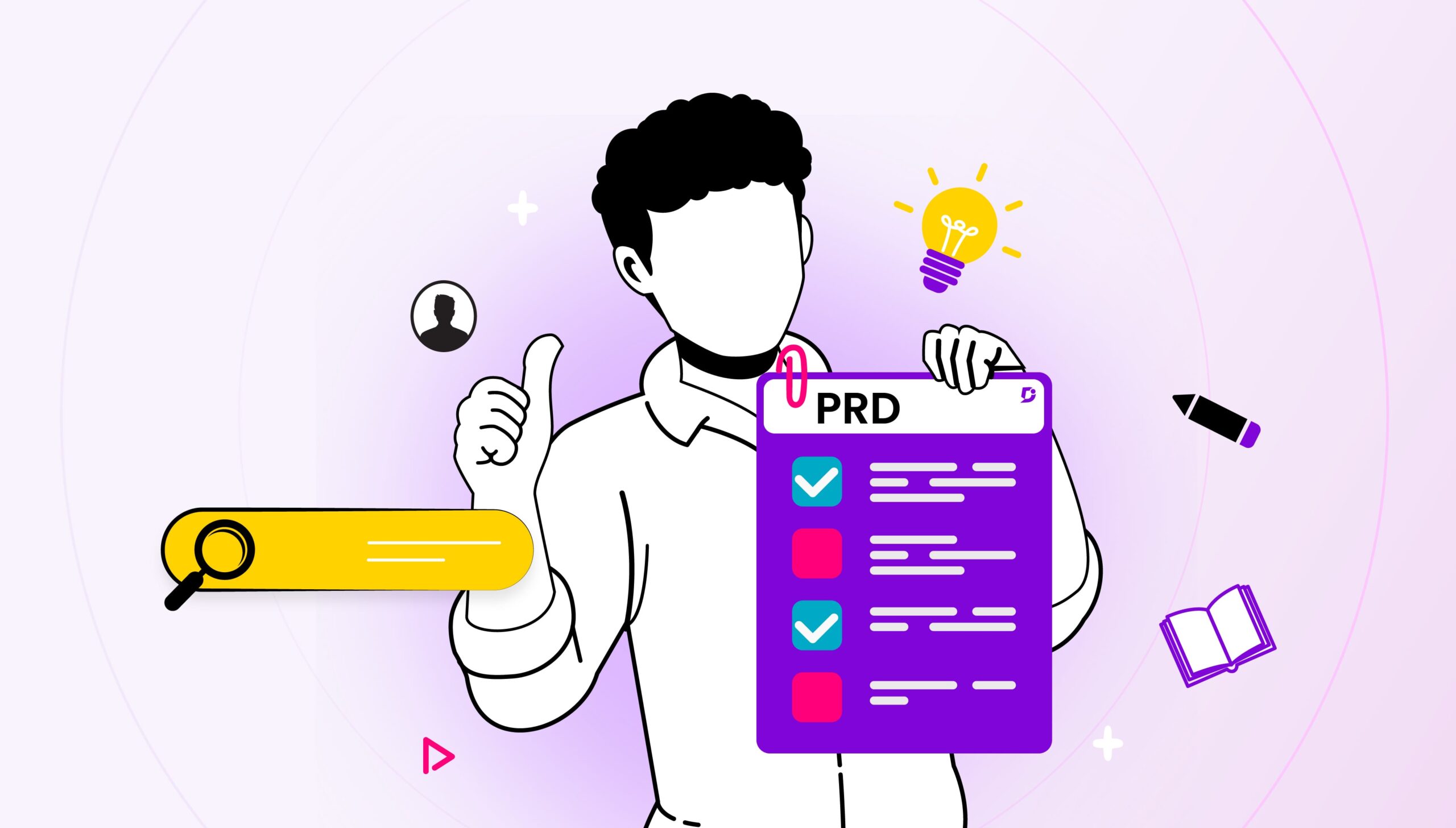Your product is the centerpiece of your company. There wouldn’t be any business for you without your product. While we are consistently making efforts to strive for product excellence, we may not always reach there. This is because product owners fail at the very roots. You may often build a product based on the basic idea you have for it. Sometimes, you may just run iterations or give feature requests to your product team.
However, you cannot just wing something that forms the crux of your business.
A country’s constitution is essential for its laws and actions. A product requirements document is necessary for product teams to develop products that gain success.
In this article, let’s talk about what a product requirements document is, tips on how you can write one, and a template as a bonus!
Let’s get started.
What Is a Product Requirements Document?
A product requirements document, or PRD, is a document that outlines the specific features and functionality of a product. Put another way. You write a PRD to help people comprehend what your product will perform. The PRD acts as a guide for all subsequent documents in the release. Therefore, it is critical to record all of the product’s required features. You can use it to communicate with stakeholders, as well as to guide the development process. To create a successful PRD, it’s essential to understand the product’s goals and target audience.
PRD vs MRD
Product Requirement Document (PRD) and Market Requirement Document (MRD) are both essential documents with different functions.
In simple terms, as stated by Bhupesh Sharma, Director of Product at American Express, “A PRD outlines the essential requirements of a product: its purpose, key features, functionalities, and behavior.”
A PRD is typically authored by a Product Manager in close collaboration with several cross-functional teams, including:
- Engineering team
- Design team
- Quality Assurance (QA) team
- Marketing
- Operations and Support
A Market Requirement Document or MRD is a strategic tool in product management that deals with the question, why this product? It defines market segments, customer needs and wants, and competition. The MRD is obtained through market analysis, which (MRD) is a strategic tool in product management that deals with the question of why this product is needed. Establishes a list of customers’ requirements that dictate product development. It contains highlights in terms of the new product, clients or customer target market, competitors, and constraints to customer acquisition. MRD is authored by product managers or product marketing managers.
On the other hand, PRD is a mechanism that transforms the interpretation contained in the MRD into tangible features and specifications for a product under development. While the MRD outlines customer requirements from a market perspective, the product will provide the necessary solutions from a product perspective, and this is outlined in the PRD.
Both are important, as the MRD gives an overall aim, and the PRD offers tactician routes toward achieving that aim. Combined, they guarantee that a product responds to the requirements of the market and that the requirements are not only action-oriented but also clear.
What Should Your Product Requirements Document Include?
You must include every explicit capability necessary for the release in the PRD.
Each desired feature should be accompanied by a use case that demonstrates how a consumer will use the functionality and informs the test plan.
Sub-items could be used for more depth and specificity for technical teams if a feature is complex. When applicable, each sub-item should have its use case.
The PRD should include any extra support in addition to functional ones.
This consists of any system or environmental requirements (for example, this product must run on iOS) and other usability needs.
The PRD typically contains the following:
Product Overview
When working on a product, it is vital to have a clear and concise product overview.
This document is typically created by the product manager and outlines the key features and benefits of the product. The product overview should be included in the product requirements document (PRD) and used to help communicate the product vision to the development team.
Goals and Objectives
This section explains why you created this product in the first place. It gives context to the product life cycle and how it fits into your company’s or product’s overall purpose and vision.
Here, attempt to clarify the problem your product is solving.
User Requirements
User requirements are the foundation of any product or service. Without a clear understanding of what users need and want, it’s impossible to create a successful product.
A PRD (Product Requirements Document) is one of the best ways to capture user requirements.
To create an effective PRD, it’s essential to understand your target users and their needs clearly. Only then can you accurately capture them in your PRD.
Functional Requirements
Functional requirements can be high-level or detailed, depending on the stage of product development.
For example, early in the product development cycle, functional requirements might simply state that the product must be able to log in to users and display data.
But as development progresses, functional requirements might become more specific, detailing how exactly the login process will work and what kind of data will be displayed through mobile app development.
Functional requirements are essential in defining the scope of a project and can be used to create a product roadmap.
You can also use them to create user stories and help developers understand what they need to build.
Non-functional Requirements
Non-functional requirements, on the other hand, include things like performance, scalability, and security.
While functional requirements are essential, and you should include them in the PRD, non-functional requirements can often have a more significant impact on the success or failure of a product.
That’s why it’s vital to ensure that you include non-functional requirements in the product requirements document and give them the attention they deserve.
Assumptions and Dependencies
When writing a PRD, you must be aware of the assumptions and dependencies you’re making. Otherwise, you could end up with a product that doesn’t meet the needs of your users.
Assuming that your users will have a certain level of technological literacy is a common mistake.
This can lead to a product that is too difficult to use or doesn’t work on all devices.
Similarly, assuming all your users have internet access can exclude a large portion of your potential audience.
Be sure to consider how your users interact with your product and its needs.
By taking the time to consider these things, you can avoid making false assumptions that could prevent your product from being successful.
Release Schedule
In the product requirements document, the release schedule is the list of dates when each version of the product will be released.
This is important information for stakeholders to know so they can plan accordingly.
Each release should include new features or improvements, and the schedule should be updated accordingly.
Now that you’ve understood the contents, it’s time to look at an easy product requirements document template.
Interested in Document360 AI-Powered Knowledge Base? Schedule a demo with one of our experts
Book A Demo
Also read: Test Specification Documents: A Complete Guide
What Are the Benefits of a Writing Product Requirements Document?
There are many benefits to having a well-written PRD, including-
- Clarifying the product vision and goals.
- Defining the target market and user requirements.
- Facilitating alignment among stakeholders.
- Improving the chances of success for the product.
- Reducing the risk of scope creep.
If you’re working on a new product, take the time to create a PRD. It will save you time and money in the long run and increase the chances of success for your product.
Steps to Create PRD
Creating a well-documented PRD requires a collaborative effort from your team. Here, we will explain the critical steps to follow; later, you can extend them according to your requirements.
Identify user personas and their needs by user research
How do you ensure that the product you are coming up with will positively impact users? It begins with the identification of these individuals and what they require. User personas derived from research help you ascertain that your product planning takes into consideration the specific demographics, job roles, challenges, goals, and behaviors.
It is not a matter of guesswork—instead, it uses data-driven processes. This ranges from Google Analytics, Hubspot, and even straightforward feedback from the users, which can lead to additional identification of demographic information concerning the users and information on their job titles, goals, objectives, and challenges the target market faces.
Having these personas defined at the start of the discovery process is, therefore, not just about meeting expectations; it is about going beyond them. It makes things customer-oriented, increases satisfaction and customer loyalty, and provides basic conditions for product long-term success.
Translate user and business needs into product features
Turning the user and business needs into product features helps avoid creating features that do not have a demand or real utility. For example, if the users have a problem with ineffective workflow patterns, then incorporating additional tools into the process is not going to solve the issue.
The process starts with analyzing user feedback to identify fundamental problems. But it’s not only about the end-users – business-oriented goals also play a significant part. In cases where increasing user engagement is necessary, and users require more detailed analytical data a dashboard can be a problem-solving tool.
By matching the product’s features with the user requirements and business goals and objectives, you design a product that not only meets the user’s requirements but is also profitable for the business.
Draft PRD by Prioritize requirements: must-haves, want-to-haves, and nice-to-haves
To streamline development and focus efforts, while drafting a Product Requirement Document (PRD), it is important to prioritize requirements. categorizes features into three tiers: must-haves, want-to-haves, and nice-to-haves.
The must-haves are the essential requirements that allow the product to perform its basic tasks. Without them, one gets a product that is either incomplete or cannot be used in any way. They are the very basics that can make people select the product out of the numerous products available in the market. The product should also address the key pain point that was identified during user research.
For example, in a task management app, the feature that allows for creating tasks and editing/removing them is a basic feature. These features are crucial and must be provided to ensure the product does the expected job.
Want-to-haves makes a product more appealing due to premium features that enhance user experience. They are not strictly required for the most basic usability of a computer, but they offer benefits in terms of time-saving, customization, and, therefore, user satisfaction and market advantage.
It sets a product apart from simply being sufficient to meet users’ expectations into one that excels in meeting them. It makes a product more appealing due to premium features that enhance user experience. They are not strictly required for a computer’s most basic usability, but they offer benefits in terms of time savings.
Consider them additions that take something already good and make it ‘over the top’. For instance, while developing a task management app, some of the main features will be the basics, such as creating, editing, or deleting tasks.
But what about nice-to-haves features like the ability to get a reminder when the task is due, integration with my calendar, or choice of themes? These are nice-to-haves—none is a necessity, although the presence of each enhances the utility, fun, or visibility of the app in a sea of competition.
For want-to-haves—they’re not required for the app to work, but they make it more useful, more engaging, and more likely to stand out in a crowded market.
Nice-to-haves are often overlooked but crucial for a standout user experience. These features are the last things that customers are willing to pay for, they play a critical role in delivering exceptional user value. These are not primary features; however, they enhance the users’ experience and give the products uniqueness.
For instance, in a task management app, some of the app features, such as Dark mode or intelligent task scheduling, are not essential to the App’s functionality but are, however, features that increase user satisfaction. While dark mode is all about enhancing the look, particularly during night operation, AI prioritization provides a touch of smart and intelligent appearance. Such nice-to-have features enhance the use of the product and prove that the user is being cared for and that the company is continually investing in product improvements.
Secure approval of key stakeholders or project sponsors
It is rather sad to spend time and money on developing a well-article PRD only to find out that the document does not have the buy-in of decision-makers who can fund the project.
Suppose you put all your efforts into accomplishing a specific task, and it was rejected because it did not meet certain standards. This is why the support of the main stakeholders, for example, senior executives, product managers, or department heads, is critical.
Such decision-makers ensure the project aligns with the organizational strategic plan and has all the prerequisites for success. If they okay the project, then it is on the right track, and resources will be provided.
How to secure approval
Engage Early: Engage all the stakeholders right from the beginning. Give out drafts, collect feedback, and establish rapport.
Present Persuasively: Emphasize the business value, its linkage to the organization, and benefits that are supported by backup evidence.
Address Concerns: When someone challenges you on timelines, budget, or a certain feature/calendar, be prepared with a sharp answer or an alternative plan.
So, before you move forward, ask yourself: Do you have the top management buy-in?
Store it in an accessible location for the team
You’ve dedicated time fine-tuning your PRD, but what if it’s lost in the shuffle? If not easily accessible, then there is bound to be so much confusion and delays toward the accomplishment of set goals. Time is of the essence. PRD should be easily reachable by your team at any time of the project – whether to recall the details of the requirements for some feature, return to the goals that were set, or check that everyone has the same understanding of the objectives.
If the document is stored, for instance, in an obscure folder or in the middle of hundreds of received emails, that accessibility disappears, and the business loses steam.
Guidelines for Making Your PRD More Accessible
- Choose a documentation tool like Document360 that your team can easily share and access.
- Ensure that the PRD is well labeled with the project name as well as the date it was written. For example, instead of writing just “Project_X_PRD_v1”, it is written “Project_X_PRD_v1_Aug2024”.
- Integrate it with team collaboration tools like Microsoft Teams or Slack.
Ask yourself: Is your team capable of finding the PRD when it is required? If not, then it is high time to make it more accessible.
Keep a record of changes and the reasons for them
Product development is never linear, and change is bound to happen through market changes, customer feedback, or technological improvements. If it is not properly documented, your team is likely to create further confusion, make repeated errors, or even waste resources.
For example, if you alter the UI design mid-project to enhance user experience, documenting the decision and its rationale—such as feedback from usability tests—prevents confusion and disputes later.
Recording all the changes is useful when working with multiple teams. It allows you to synchronize the work and notice any effects on time or money. It also serves the purposes of documentation and communication so that people can get back on the same page.
Tips on How To Write a Good Product Requirements Document
Now, we know writing a product requirements document sounds daunting after all this. But it doesn’t have to be.
There are a few things that you will want to keep in mind.
Following these tips can create a clear, concise, and easy-to-understand document.
Keep it Simple
It is crucial to keep the language simple when writing a requirements document. This document is not a place to use jargon or technical language. Instead, use language that everyone on the team can understand.
Be Concise
Requirements documents should be short and to the point. There is no need to include lengthy descriptions or long lists of items. Stick to the essentials and be as concise as possible.
Be Clear
The requirements document must be clear and easy to understand. You should state each requirement clearly and concisely. Any ambiguity can lead to confusion and errors down the road.
Include Examples:
It is a good idea to include examples in the requirements document. This can help clarify the requirements and ensure everyone on the team is on the same page.
Get Feedback
Before finalizing the requirements document, getting feedback from the team is crucial. This will ensure that the document is clear and concise and that there are no misunderstandings.
With a little effort, you can create a document that will help ensure your product’s success.
Well, these are some tips based on things you should do.
Also, check out our Guide to Create Technical Specification Document
Mistakes to avoid while writing a PRD
Not Doing Your Research
Before you start writing your PRD, it’s essential to do your research. This includes understanding your target market, your competition, and your product’s unique selling points. Without this research, it will be challenging to write an effective PRD.
Getting Too Technical
You should write your PRD in plain English. Avoid using jargon or getting too technical. Remember, your PRD is for stakeholders who may not be familiar with the product or the industry.
Making Assumptions
Don’t make assumptions about what your product should do or how it should work. Instead, base your product requirements on customer feedback and market research
Being Too Vague
Be as specific as possible when writing your PRD. This will help your team understand the requirements and create a more successful product.
Not Getting Stakeholder Feedback
Make sure to get feedback from stakeholders before finalizing your PRD. Their input can help to improve the quality of your document.
By following these tips, you can write a great product requirements document. Be sure to keep it simple, clear, and concise, and get feedback from the team.
Let’s look at a product requirements document example to give you a practical and comprehensive understanding of everything we have discussed.
Product Requirements Document Template
If you’re just starting, remember to keep it simple. Don’t get bogged down by the details.
You can always use the SMART goal-setting framework while making your product requirements document and not making it too complicated.
So here’s a simple yet efficient product requirements document template you can begin with and gradually scale.

When in doubt, come back to this PRD template and utilize it. It is wise to use the right tool to document, you can try software documentation tools like Document360 that help with product requirements documentation.
Wrapping Up
PRD is a must-have document that helps organize the teams and guarantee product success. Thus, the product itself, the requirements of the subject, technical documentation, and the risks of the project become clearly defined. The PRD ensures that the product developed is relevant to the market’s needs and provides value to the customers. Getting to a PRD, therefore, cannot be a solitary affair as this requires teamwork together with proactivity in the development of drafts, This therefore makes PRD require clear communication and constant changes.
Are you ready to have well-coordinated documents? Document360 provides almost everything necessary to easily create, manage, and organize PRDs. Start using Document360 today and help secure your product development process to be on schedule and strategy!
An intuitive knowledge base software to easily add your content and integrate it with any application. Give Document360 a try!
GET STARTED




 –
– 

